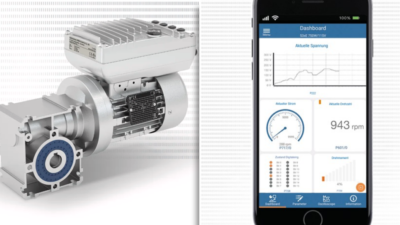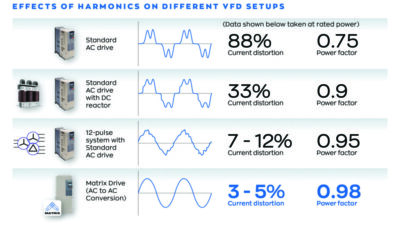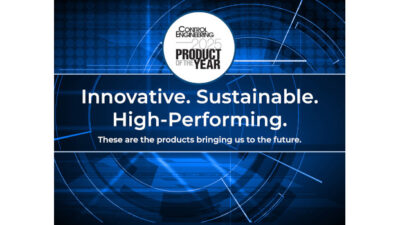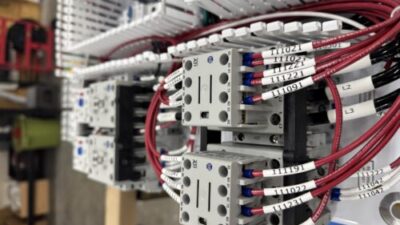Adjustable-speed drives deliver precise speed control to motors in a variety of applications to make optimal use of consumed energy. Among the many benefits motor users can achieve through use of drives are lower power demand on startups, elimination of some mechanical drive components, and the potential to reduce power line disturbances with the use of special filters.
|
Adjustable-speed drives deliver precise speed control to motors in a variety of applications to make optimal use of consumed energy. Among the many benefits motor users can achieve through use of drives are lower power demand on startups, elimination of some mechanical drive components, and the potential to reduce power line disturbances with the use of special filters.
Most manufacturers of ac drives utilize the same core technologies; there is little functional difference among processors and algorithms at the heart of drives. Most obvious differences are found in form factors, interfaces, and applications offer by vendors.
With these facts in mind, buyers should consider several key features when evaluating the purchase of a drive.
First, users should ensure that the drives they’re considering suit their applications. For example, OEMs whose products serve a wide variety of customers with diverse needs might want enormous flexibility in their drives, such as ability to control acceleration, limit torque, and control stopping to prevent wear and tear. But a user with a basic HVAC application might need only an inexpensive, basic drive equipped with a potentiometer to control fan speed.
As is the case with most industrial products, ease of use is highly valued by most drives users. Buyers should consider time to install and commission drives. While complex drives are highly configurable, with hundreds of parameters that can be adjusted, as well as built-in motor-control schemes, many users can be intimidated by having to change most of those settings to get the drive up and running. However, with today’s software refinements, some drives manufacturers find it economical to incorporate the numerous parameters into the product, and then just activate those needed by specific customer applications. Users also should consider how much outside support—if any—will be necessary during startup.
Although most users want their drives to be relatively easy to use, many will want to ensure that only authorized personnel will be able to make parameter changes. Those users should make sure that the drives they are considering have built-in security to prevent unwanted reconfigurations.
Drive size also is an important consideration, since space is at a premium in many plants. Many drives are compact units that can be wall-mounted, but more complex units are available in floor cabinets with operator interfaces embedded in their doors.
Ease of use and ergonomics also are important factors to consider in purchasing drives. For example, if workers typically wear work gloves, buttons on a control panel should be large, so users do not have to remove their gloves. Users also should consider the brightness of control panel screens, if they need screens visible from a distance, and if displays use graphics or strictly alphanumeric readouts. In addition, say several leading vendors, users should consider the nature of information displayed in making selections. For example, while some drive interfaces display easy-to-understand messages in straightforward language, others display numeric codes, interpretation of which requires users to consult manuals.
Potential users should also consider programmability of drives, says Mark Kenyon, ABB’s product manager for low-voltage drives.
“Among the questions buyers should ask are: Can I program the drive for my specific application? Can drive firmware be changed so it’s specific to a user? If the drive is being used for a specialized application, such as a winder, an extruder, or a centrifuge, can you write code for the specific drive?” says Kenyon. “Usually these are questions that OEMs face in buying drives in large volumes, but large end-users should probably consider these issues as well.”
Users should also factor support into buying decisions. With many users standardizing control platforms across multiple plants around the world, it is essential they get fast, global support. Buyers should carefully examine availability and terms, particularly of vendors with limited representation in some areas of the world.
With a wide range of sizes, power ratings, and options, drive prices vary considerably. For example, at the low end of the cost spectrum, the simplest drives can be purchased for approximately $100 (or approximately $5,000 for a 50 horsepower drive). These are bare-bones models that generally use inverter technology, involve open-loop control, and do not allow for programming or additional features. (Simple controls, such as a potentiometer, may be available as options on some units).
Higher-end drives generally cost an additional $30 per unit of horsepower (or $6,500 for a 50 horsepower drive). For the additional money, users gain more extensive programmability, networking capabilities, additional analog and digital outputs, closed-loop control, and a variety of other features.
Another potentially important factor affecting drive cost is compliance with a variety of international standards.
AC drives checklist
Make sure the drive’s capabilities are suited to your needs
Consider ease-of-use issues, such as the ability to quickly install and start up the drive, intuitive controls, etc.
Does the drive fit into available wall or floor space?
What are enclosure requirements?
Can the drive be programmed for specialized applications, such as centrifuges and extruders?
Does the drive comply with international standards (if planned for use outside of U.S.)?
Is support readily available, particularly for installations outside the United States?



